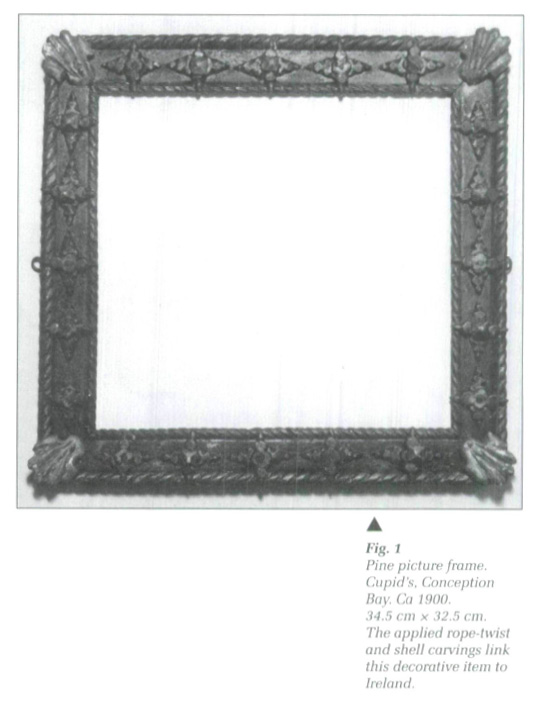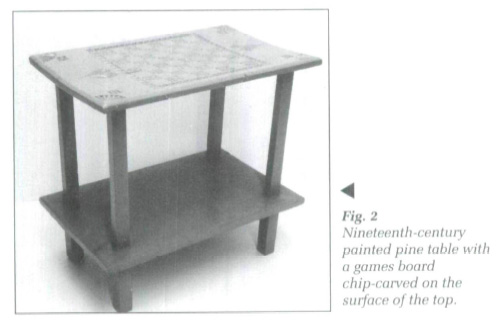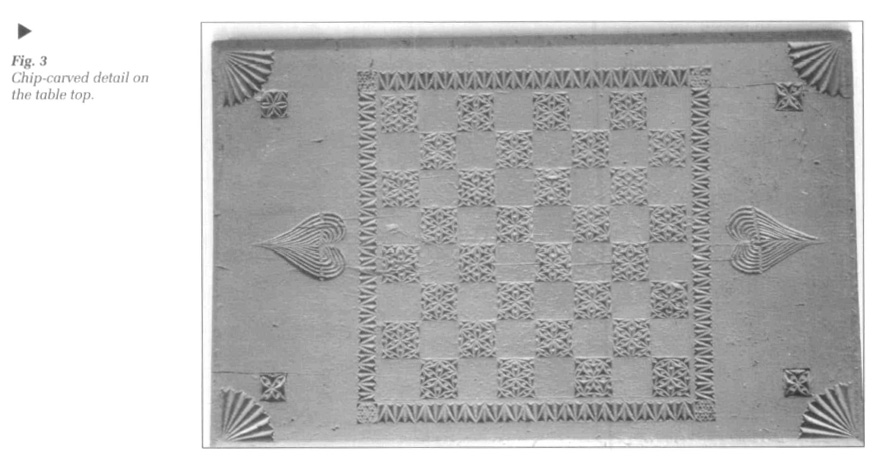Notes and Comments / Nouvelles brèves
Recent Acquisitions, Newfoundland Museum, St. John's
1 Recently, the Museum collected a pine picture frame (Fig. 1) from the town of Cupids, Conception Bay. The applied rope-twist and shell carvings link this generously decorated item to Ireland. The rope-twist motif is commonly found on buildings in Irish coastal towns as well as on pieces of Irish furniture. Shell carvings were used by Irish carpenters as decorations both on shop fronts and on furniture. (See Bernard D. Cotton, "Irish Vernacular Furniture," Regional Furniture 3 (1989)). The picture frame is finished in several contrasting colours over a white ground. The rope-twist carvings are painted bronze; the shell carvings and the tiny pyramid-shaped pieces of wood (many of which are missing) surmounting the chip-carved crosses are highlighted with a brown pigmented glaze; and the remainder of the item is painted red. The frame measure 34.5 cm by 32.5 cm and was probably made in Cupids ca 1900.
2 The Newfoundland Museum also collected a nineteenth-century painted pine table (Fig. 2) with a games board chip-carved on the surface of the top. This Newfoundland-made table was acquired from the Hoddinot family in Grand Falls. Despite the fact that the carving (Fig. 3) is covered over with several layers of paint, it is obvious that it was executed with great skill. The chip-carving suggests the influence of Scandinavia and, perhaps, Ireland. Chip-carving, of course, is a Scandinavian vernacular device. Shell carvings similar to those gracing the corners of the table top were decorations employed by Irish carpenters.
 Display large image of Figure 1
Display large image of Figure 13 At first glance the table itself, unlike the chip carving, appears to be an unimpressive, naively assembled, piece of work. When it is examined carefully, however, evidence of ingenious craftsmanship is revealed. The squared legs, for example, do not simply pass through the lower shelf. Cut into the sides of each one is a shoulder or groove, in which the lower shelf is snugly fitted. More interestingly, the tops of the legs do not terminate at the underside of the table as they appear to do. Instead, each one of the leg tops is reduced in size so that it forms a tenon which passes through an open mortise to rest flush with the top surface of the table. The visible ends of these through tenons are chip-carved to match and enhance the other chip-carved decorations which adorn the top of the table. They can be seen just in front of each one of the four shell or fan carvings. A truly observant individual might notice that the end of one of these four visible tenons is carved differently that the other three. While three have a pattern consisting of four loops. one is favoured with six. Perhaps the carver first completed the pattern of six loops to be consistent with what he had already done on the games board. Having then experienced the difficulty of carving on endgrain. he prudently decided to make his task easier by reducing the number of loops in his pattern to four.
 Display large image of Figure 2
Display large image of Figure 24 Another reason the table, itself, may appear unimpressive at first glance might be due to the simplicity of its design. Perhaps the maker chose to keep the design of the table simple so that it would not compete for attention with the excellence of his carving.
